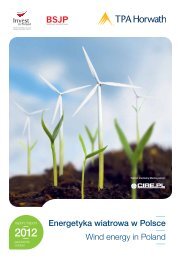Energetyka wiatrowa w Polsce Wind energy in Poland - TPA Horwath
Energetyka wiatrowa w Polsce Wind energy in Poland - TPA Horwath
Energetyka wiatrowa w Polsce Wind energy in Poland - TPA Horwath
You also want an ePaper? Increase the reach of your titles
YUMPU automatically turns print PDFs into web optimized ePapers that Google loves.
6<br />
6.1<br />
Bariery <strong>in</strong>westycyjne – Polska<br />
na tle UE 33<br />
Bariery adm<strong>in</strong>istracyjne<br />
Adm<strong>in</strong>istrative barriers<br />
Pod względem barier adm<strong>in</strong>istracyjnych Polska<br />
nie wyróżnia się spośród <strong>in</strong>nych państw Unii Europejskiej.<br />
Proces od momentu podjęcia decyzji<br />
o budowie elektrowni wiatrowej do jej uruchomienia<br />
w całej Unii jest zbliżony i opiera się na<br />
uzyskaniu dwóch głównych pozwoleń. Pierwsze<br />
z nich to pozwolenie na budowę, drugie dotyczy<br />
natomiast podłączenia elektrowni do sieci energetycznej.<br />
Różnice między formalnościami w różnych<br />
państwach wynikają z wymogów w zakresie dokumentów<br />
i analiz, jakie są wymagane do uzyskania<br />
obu pozwoleń, a także z term<strong>in</strong>ów, w jakich urzędy<br />
są zobowiązane rozpatrzyć wniosek.<br />
Do najczęściej wymienianych barier <strong>in</strong>westycyjnych<br />
w UE zalicza się ponadto procedury związane<br />
z uzyskaniem oceny wpływu <strong>in</strong>westycji na środowisko<br />
oraz z planem zagospodarowania przestrzennego.<br />
Istotną techniczną przeszkodą jest również<br />
przestarzała <strong>in</strong>frastruktura sieci elektroenergetycznej,<br />
która jest przystosowana bardziej do przesyłania<br />
energii z małej ilości dużych źródeł (elektrownie<br />
konwencjonalne i atomowe), niż wielu mniejszych.<br />
Znaczna część <strong>in</strong>westycji została też spowolniona<br />
przez pozwy sądowe i działania organizacji pozarządowych.<br />
Diagnoza polskich, aktualnie postrzeganych<br />
przez uczestników rynku za najistotniejsze<br />
barier <strong>in</strong>westycyjnych, w dużym stopniu pokrywa się<br />
z tendencją europejską.<br />
Dla projektów morskich farm wiatrowych, jako<br />
stosunkowo nowych obszarów działalności, istotne<br />
ograniczenia <strong>in</strong>westycyjne to brak wystarczających<br />
regulacji prawnych, niewystarczający system<br />
wsparcia <strong>in</strong>westycji offshore, brak doświadczonych<br />
służb adm<strong>in</strong>istracyjnych oraz niejasne wymagania<br />
środowiskowe. W ostatnim czasie m<strong>in</strong>isterstwo<br />
środowiska oraz m<strong>in</strong>isterstwo rolnictwa i rozwoju wsi<br />
zgłosiły zastrzeżenia, co może skutkować odmową<br />
wydania pozwoleń na wznoszenie sztucznych wysp<br />
w niektórych lokalizacjach i wpłynąć hamująco na<br />
dalsze prowadzenie projektów offshore.<br />
Do najważniejszych ograniczeń w rozwoju podsektora<br />
zaliczyć należy ponadto brak unormowań<br />
prawnych dotyczących obowiązku przeprowadzenia<br />
niezbędnych <strong>in</strong>westycji w zakresie rozbudowy<br />
<strong>in</strong>frastruktury sieciowej przystosowanej<br />
do odbioru energii z elektrowni zlokalizowanych<br />
w polskiej strefie ekonomicznej Bałtyku.<br />
33 Na podstawie „<strong>W<strong>in</strong>d</strong>Barriers: Adm<strong>in</strong>istrative and grid Access barriers<br />
to w<strong>in</strong>d power”, The European <strong>W<strong>in</strong>d</strong> Energy Association, lipiec 2010<br />
Investment barriers – <strong>Poland</strong> <strong>in</strong> the<br />
context of European Union 33<br />
As far as adm<strong>in</strong>istrative barriers are concerned, <strong>Poland</strong><br />
does not stand out among other European Union<br />
Member States. The process that beg<strong>in</strong>s with the<br />
decision concern<strong>in</strong>g the construction of a w<strong>in</strong>d farm<br />
and ends with putt<strong>in</strong>g the farm <strong>in</strong>to service is similar<br />
throughout the entire European Union, and it relies on<br />
two essential permits that need to be obta<strong>in</strong>ed: the<br />
first be<strong>in</strong>g the construction permit, and the second<br />
allow<strong>in</strong>g for farm connection to the power grid.<br />
Differences <strong>in</strong> formalities between <strong>in</strong>dividual countries<br />
lie <strong>in</strong> documents and analyses required to obta<strong>in</strong> the<br />
said permits, and <strong>in</strong> deadl<strong>in</strong>es by which authorities are<br />
obliged to exam<strong>in</strong>e the application.<br />
The most frequently mentioned <strong>in</strong>vestment barriers <strong>in</strong><br />
the EU also comprise procedures related<br />
to obta<strong>in</strong><strong>in</strong>g environmental impact assessment for<br />
the <strong>in</strong>vestment, and the land development plan. An<br />
outdated power grid <strong>in</strong>frastructure also constitutes<br />
a major technical obstacle, as it is designed to transmit<br />
<strong>energy</strong> from a few large sources (conventional and<br />
nuclear power plants) rather than from a large number<br />
of small sources. A large number of <strong>in</strong>vestments have<br />
also been slowed down because of lawsuits and<br />
NGO actions. The diagnosis of Polish <strong>in</strong>vestment<br />
barriers that market players currently perceive as the<br />
most obtrusive largely corresponds to the European<br />
tendencies.<br />
As far as offshore w<strong>in</strong>d farm projects are concerned,<br />
s<strong>in</strong>ce such projects constitute a relatively new area of<br />
operations, key <strong>in</strong>vestment limitations <strong>in</strong>clude absence<br />
of sufficient legal regulations, <strong>in</strong>sufficient aid system<br />
for offshore <strong>in</strong>vestments, absence of experienced<br />
adm<strong>in</strong>istrative personnel, and unclear environmental<br />
requirements. Recently, the M<strong>in</strong>istry of the Environment<br />
and the M<strong>in</strong>istry of the Agriculture and Rural Area<br />
Development made their reservations. This may result<br />
<strong>in</strong> the refusal to issue permits for the construction<br />
of artificial islands <strong>in</strong> some locations and h<strong>in</strong>der the<br />
further implementation of offshore projects.<br />
Furthermore, the most important limitations to the<br />
subsector development <strong>in</strong>clude the lack of legal<br />
regulations govern<strong>in</strong>g the obligation to perform<br />
necessary <strong>in</strong>vestments <strong>in</strong> the field of the development<br />
of the grid <strong>in</strong>frastructure adapted to collect power from<br />
power plants located <strong>in</strong> the Polish Baltic economic<br />
zone.<br />
33 Accord<strong>in</strong>g to „<strong>W<strong>in</strong>d</strong>Barriers: Adm<strong>in</strong>istrative and Grid Access Barriers<br />
to <strong>W<strong>in</strong>d</strong> Power”, The European <strong>W<strong>in</strong>d</strong> Energy Association, July 2010<br />
<strong>Energetyka</strong> <strong>wiatrowa</strong> w <strong>Polsce</strong> / <strong>W<strong>in</strong>d</strong> <strong>energy</strong> <strong>in</strong> <strong>Poland</strong><br />
63



